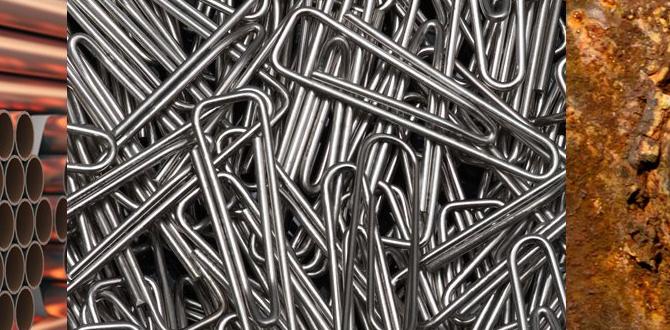Your 1/8″ carbide end mill is a game-changer for aluminum, offering precision and speed. This guide makes it your go-to tool for amazing results on your milling projects. Let’s unlock its full potential!
Hey there, fellow makers! Daniel Bates from Lathe Hub here. Ever stared at a piece of aluminum, itching to mill it, but felt a bit intimidated by the tiny tools? If you’ve wrestled with aluminum and ended up with gummy messes or less-than-perfect finishes, you’re not alone. It can be tricky! But what if I told you there’s a tiny powerhouse of a tool that can make working with aluminum a breeze? Today, we’re diving deep into the world of the 1/8″ carbide end mill. This little but mighty tool is an absolute genius for aluminum, no matter what kind you’re working with. We’ll cover why it’s so great, how to use it safely and effectively, and how to get those crisp, clean cuts you’ve been dreaming of. Get ready to feel more confident than ever in your milling adventures!
Why the 1/8″ Carbide End Mill is Your Aluminum’s Best Friend
When it comes to milling aluminum, especially softer grades like 6061 or the tougher 7075, tool choice is critical. Aluminum can be sticky and prone to “gumming up” tools, which leads to poor finishes, broken cutters, and a lot of frustration. This is where our small but mighty 1/8″ carbide end mill shines. Its small diameter means it can get into tight spaces and create intricate details, perfect for hobbyist projects, PCBs, or delicate engraving. But don’t let its size fool you; it’s built for performance.
Carbide is a super-hard material, far harder than the High-Speed Steel (HSS) often used for smaller end mills. This hardness translates to superior wear resistance and the ability to cut at higher speeds. For aluminum, this is fantastic because you can often achieve higher Material Removal Rates (MRR) without overheating or damaging the tool. The sharp edges of a carbide end mill bite into aluminum cleanly, preventing that annoying buildup. So, while it might seem small, this 1/8″ carbide end mill is a powerhouse for anyone working with aluminum.
Understanding the 1/8″ Carbide End Mill
Let’s break down what makes this specific size and material so effective for aluminum.
Carbide: The Secret Sauce
Carbide, specifically tungsten carbide, is renowned for its incredible hardness and strength. When ground into an end mill, it results in:
- Superior Hardness: It can withstand higher cutting temperatures than HSS, allowing for faster machining speeds.
- Edge Retention: Carbide edges stay sharp for much longer, meaning fewer tool changes and more consistent results.
- Rigidity: Despite its size, carbide is quite rigid, which helps in achieving accurate cuts and minimizing chatter, especially with delicate details.
The “1/8 Inch” Advantage
Why 1/8 inch (approximately 3.175mm)? This size is incredibly versatile for several reasons:
- Detail Work: Perfect for milling intricate pockets, slots, contours, and engraving on projects where precision is key. Think custom parts, artistic designs, or even circuit board traces.
- Accessibility: It fits into a vast range of CNC machines and mill collets, especially those designed for hobbyist or desktop use.
- Reduced Tool Pressure: The smaller diameter generally requires less clamping force and puts less stress on your workpiece and machine compared to larger end mills.
Stub Length vs. Standard Length
You’ll often find these small end mills in “stub length.” What does that mean? A stub length end mill has a shorter flute length and a shorter overall length compared to a standard end mill of the same diameter. This design offers:
- Increased Rigidity: Less overhang means less chance of deflection or vibration, leading to straighter, more accurate cuts. This is incredibly important when milling tough materials like 7075 aluminum.
- Higher MRR Potential: Because they are more rigid, stub length end mills can often handle slightly higher feed rates and depths of cut, contributing to a good MRR.
Specifics for Aluminum: Flute Count and Helix Angle
When choosing a 1/8″ carbide end mill specifically for aluminum, look for these features:
- 2 Flutes: Generally, 2-flute end mills are preferred for aluminum. The larger chip gullets (the space between the flutes) allow chips to evacuate more easily, preventing the sticky aluminum from clogging the tool.
- High Helix Angle: A high helix angle (often 30-45 degrees) helps “sweep” chips away from the cutting edge and out of the workpiece, further reducing the risk of clogging and improving surface finish.
Choosing the Right 1/8″ Carbide End Mill for Aluminum
Not all 1/8″ carbide end mills are created equal, especially when it comes to aluminum. Here’s what to look for:
Material Grade
For general-purpose aluminum machining, a standard uncoated carbide end mill will work well. However, for more demanding applications or to extend tool life, consider:
- ZrN (Zirconium Nitride) Coating: This coating is excellent for aluminum. It’s slick, reducing friction and chip welding, and has good hardness.
- TiB2 (Titanium Diboride) Coating: Another top contender for aluminum, offering an extremely low coefficient of friction.
- AlTiN (Aluminum Titanium Nitride) Coating: While great for steels, AlTiN can sometimes react with aluminum at high temperatures, leading to built-up edge. For aluminum, ZrN or TiB2 are usually better choices.
Shank and Cutting Diameter
Ensure the shank diameter is 1/8 inch (3.175mm). The cutting diameter will also be 1/8 inch for a square end mill – perfect for creating square pockets and shoulders. If you need to profile or slot, this is your go-to.
The “Stub Length” Consideration
As mentioned, stub length end mills for this diameter are often ideal for aluminum as they provide maximum rigidity. This minimizes deflection, which is crucial for maintaining accuracy and getting a clean cut on slightly harder aluminum alloys.
Where to Find Quality Tools
Reputable tool manufacturers offer excellent 1/8″ carbide end mills specifically designed for non-ferrous metals like aluminum. Look at brands known for quality cutting tools. For a fantastic overview of cutting tool basics and considerations, the Sandvik Coromant guide to machining non-ferrous metals is an invaluable resource.
Setting Up Your Machine for Success
Getting the most out of your 1/8″ carbide end mill for aluminum involves a few key setup steps. These small adjustments make a big difference.
Collet and Spindle Check
A good quality collet that is clean and fits the 1/8″ shank perfectly is essential. Ensure your spindle runs true and doesn’t have excessive runout. Even tiny runout on such a small tool can lead to incomplete cuts or tool breakage.
Workholding is Key
Secure your aluminum workpiece firmly. Use clamps, a vise with soft jaws, or double-sided tape specifically designed for machining if your part is thin or delicate. Aluminum can move under cutting forces, so solid workholding prevents surprises and ensures accuracy.
Coolant/Lubrication (Optional but Recommended)
While some high-performance end mills can cut dry, using a lubricant or coolant significantly improves results with aluminum. It:
- Keeps the cutting edge cool, extending tool life.
- Helps flush chips away, preventing buildup.
- Improves surface finish.
For hobbyists, compressed air can be effective for chip evacuation. For more serious machining, a flood coolant system or a spray mist system is ideal. You can also use specialized aluminum cutting fluid.
Machining Parameters: Finding the Sweet Spot
This is where we get into the nitty-gritty of cutting. Getting the speeds and feeds right is crucial for both tool life and the quality of your aluminum parts. For a 1/8″ carbide end mill and aluminum, we aim for high surface speeds but manage chip load carefully.
Surface Speed (SFM) and Spindle Speed (RPM)
Carbide can handle higher surface speeds than HSS. A good starting point for aluminum with a 1/8″ carbide end mill is often in the range of 300-600 SFM (Surface Feet per Minute). To convert this to RPM (Revolutions Per Minute) for your machine, you use the formula:
RPM = (SFM 3.25) / Diameter (inches)
For a 1/8″ end mill (0.125″):
RPM = (300 3.25) / 0.125 = 7,800 RPM
RPM = (600 3.25) / 0.125 = 15,600 RPM
This means you’ll likely be running your spindle at the higher end of its capabilities, which is where dedicated high-speed spindles shine. Always start at the lower end of recommended SFM and increase if your machine can handle the feed rate and chip evacuation is good.
Feed Rate (IPM)
Feed rate is about how fast the tool moves through the material. Chip load (the thickness of the chip each flute takes off) is the key. For a 1/8″ carbide end mill in aluminum, a chip load of 0.001″ to 0.002″ per flute is a good starting point. The formula for IPM (Inches Per Minute) is:
IPM = Chip Load (inches/flute) Number of Flutes Spindle Speed (RPM)
Using our 2-flute end mill and a starting chip load of 0.0015″:
IPM = 0.0015 2 * 7,800 RPM = 23.4 IPM
As you increase spindle speed or desired chip load, the IPM will increase. It’s a balancing act.
Depth of Cut (DOC) and Stepover
Depth of Cut (DOC): For a 1/8″ end mill, especially in stubborn 7075 aluminum, it’s wise to take lighter cuts. A radial depth of cut (DOC) of 0.010″ to 0.050″ is often recommended. Axial depth of cut (how deep it cuts along the Z-axis) can be more aggressive, but always consider the rigidity of your setup. A good rule of thumb is to keep the axial DOC no more than 1-2 times the diameter for general milling, but for finishing or delicate parts, much less is better.
Stepover: This is how much the tool moves sideways to clear material. For roughing, a stepover of 40-60% of the tool diameter is common. For finishing passes, you’ll want to reduce this significantly, perhaps to 10-20%, to achieve a smooth surface finish.
Example Machining Parameters Table
Here’s a quick reference table for common aluminum alloys. Always start conservatively!
| Operation | Aluminum Alloy | End Mill Type | Spindle Speed (RPM) | Feed Rate (IPM) | Axial DOC (in) | Radial DOC (in) | Chip Load (in/flute) | Notes |
|---|---|---|---|---|---|---|---|---|
| Roughing (e.g., clearing pockets) | 6061-T6 | 1/8″ 2-flute Carbide, ZrN coated | 10,000 – 15,000 | 20 – 40 | 0.050 – 0.100 | 0.050 – 0.120 (50-100% stepover) | 0.001 – 0.002 | Use air blast or mist. Good chip evacuation is key. |
| Semi-Finishing | 6061-T6 | 1/8″ 2-flute Carbide, ZrN coated | 12,000 – 16,000 | 25 – 45 | 0.020 – 0.040 | 0.020 – 0.050 (20-40% stepover) | 0.001 – 0.002 | Focus on smooth motion, reduce chip load slightly. |
| Finishing (e.g., surface finish) | 6061-T6 | 1/8″ 2-flute Carbide, ZrN coated | 14,000 – 18,000 | 30 – 50 | 0.005 – 0.015 | 0.005 – 0.015 (5-15% stepover) | 0.001 – 0.0015 | Very light cuts for best surface finish. |
| Roughing (e.g., clearing pockets) | 7075-T6 (Tougher) | 1/8″ 2-flute Carbide, ZrN/TiB2 coated | 8,000 – 12,000 | 15 – 30 | 0.030 – 0.060 | 0.040 – 0.080 (40-70% stepover) | 0.0008 – 0.0015 | Requires more rigidity. Keep an eye on chatter. |
| Finishing | 7075-T6 (Tougher) | 1/8″ 2-flute Carbide, ZrN/TiB2 coated | 10,000 – 14,000 | 20 – 35 | 0.005 – 0.010 | 0.005 – 0.010 (5-10% stepover) | 0.0007 – 0.001 | Take very light, clean passes. |
Important Note: These are starting points! Every machine, setup, and specific aluminum alloy can behave slightly differently. Listen to your machine, watch those chips, and adjust accordingly. For specific recommendations on machining aluminum, resources like Alcoa’s machining guides can offer valuable insights into material properties.
Common Problems and How to Solve Them
Even with the best tools and settings, you might run into a few snags. Here’s how to troubleshoot:
1. Gummy Buildup (Chip Welding)
Problem: Sticky aluminum is sticking to the cutting edges of your end mill, creating dull spots and poor cuts. This is the most common issue.
- Solution:
- Increase Spindle Speed (RPM): Higher speeds can help create a smaller chip load, which is less likely to weld.
- Improve Chip Evacuation: Use compressed air, mist coolant, or flood coolant to blast chips away from the cutting zone.
- Reduce Feed Rate (IPM) Slightly: This can sometimes help, but often speed is key.
- Consider a Coating: ZrN or TiB2 coatings are designed to prevent this.
- Use a Polished Flute End Mill: These have a smoother surface finish that further reduces friction.
2. Chatter or Vibration
Problem: The cut is noisy, leaving a rough, wavy surface finish. This indicates the cutting forces are unstable.
- Solution:
- Reduce Depth of Cut (DOC) and Stepover: Take lighter passes.
- Increase Rigidity: Ensure your workpiece is clamped securely. Use a stub-length end mill. Make sure your collet is tight and the




